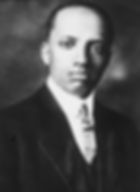Dr. Carter G. Woodson & The Rich History of Black History Month
- Ninfa O. Barnard
- Feb 2, 2022
- 3 min read
Updated: Jul 10, 2023
Woodson, the child of enslaved people, achieved much his parents couldn’t. He became a celebrated Black historian, was the second African American after W.E. B. DuBois to earn a Ph.D. from Harvard, and is known as “The Father of Black History.”

Image Credit: National Geographic
The annual celebration of February’s Black History Month finds its roots exactly 50 years after the Thirteenth Amendment abolished slavery in 1865. In the summer of 1915, Dr. Carter G. Woodson, a Black historian, attended the Lincoln Jubilee celebration in Chicago which commemorated the 50th anniversary of the emancipation of enslaved African Americans in the United States. Woodson was mesmerized by the exhibits celebrating the recent accomplishments of African Americans and the thousands of people that came from all over the country to see them. He left inspired to find more ways of honoring Black history and culture. In September of 1915, Dr. Woodson and well-known minister Jesse E. Moorland founded the Association for the Study of Negro Life and History (ASNLH), an organization resolved to study and highlight Black history, life, and heritage. (Today, the ASNLH is known as the Association for the Study of African American Life and History or ASALH.)
In 1916, Dr. Woodson and the ASNLH established The Journal of Negro History, which served as the first scientific journal to research and accurately record the advanced achievements of Black individuals throughout history. The ASNLH sponsored the first national Negro History Week in February of 1926 to coincide with celebrations of the birthdays of President Abraham Lincoln and famed, Black abolitionist Frederick Douglass. Woodson also knew that these celebrations were examples of how Black communities across America already commemorated Black history. Even so, Woodson envisioned this tradition reaching a greater depth. He wanted to study and celebrate the full scope of Black history, especially the Black people who advanced society through their inventions and achievements.
Soon after its inception, Negro History Week grew beyond the ASNLH’s expectations. Mayors in cities across the US adopted Negro History Week. The popularity of Negro History Week allowed the ASNLH to form branches and Negro History Clubs around the country, in addition to their already thorough K-12 lesson plans and curriculum.
The 1960s marked a rise in the appreciation of Black identity and the height of the civil rights movement, allowing Negro History Week to evolve into Black History Month. The Black United Students and Black educators at Kent State University expanded this idea to include an entire month beginning on February 1, 1970.
President Gerald Ford honored the importance of Black History Month as the nation celebrated its bicentennial year in 1976. He issued a statement that said, “The last quarter-century has finally witnessed significant strides in the full integration of black people into every area of national life. In celebrating Black History Month, we can take satisfaction from this recent progress in the realization of the ideals envisioned by our Founding Fathers. But, even more than this, we can seize the opportunity to honor the too-often neglected accomplishments of black Americans in every area of endeavor throughout our history.”
Since 1976, every US president has endorsed Black History Month and a specific theme. The ASALH has a list of the themes from 1928 to the present. This year’s theme is “Black Health and Wellness.”
Today the ASALH has a roster of more than 2,500 members. Its official mission is “to promote, research, preserve, interpret, and disseminate information about Black life, history and culture to the global community” and part of its vision is “...to continue Woodson’s legacy.”
With the evolution of Negro History Week into Black History Month, millions of Americans and people around the globe now honor Dr. Woodson’s dream of celebrating Black achievement through Black History Month.
Sources:
Written By: Ninfa O. Barnard



